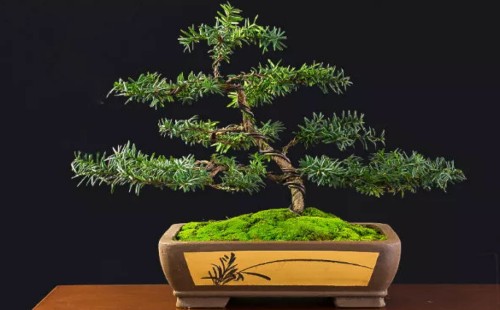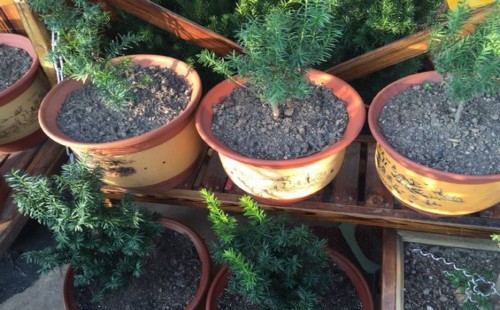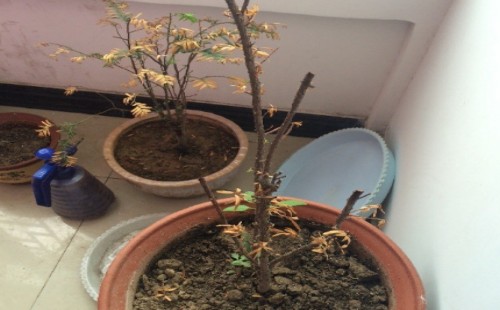How to resurrect the rotten roots of yew
Many bonsai friends like to raise bonsai trees at home, which can not only be watched, but also bring a touch of freshness and greenness to the environment, but in the process of daily maintenance and management, the most disturbing thing is a series of bad growth phenomena caused by the rotten roots of bonsai trees. there may even be a fatal phenomenon. If it is not handled properly, it may bring us great losses. Taxus is also a kind of bonsai tree that many potted friends like to plant, but they may also encounter the problem of rotten roots during planting. So, how do the rotten roots of yew come back to life?

If we want to successfully rescue the rotten root of the yew to reduce the loss, we need to find out the real cause of the rotten root before we can take the necessary measures to save it. In the process of practice, the phenomenon of rotten roots of Taxus mairei is mainly manifested in the improper management of water and fertilizer, which is generally caused by excessive watering caused by stagnant water in the basin, or due to the high concentration of fertilization and the application of raw fertilizer. We can judge according to these two ideas.
Now that Taxus has rotted roots, in order to bring it back to life smoothly, we should not only take scientific measures in time, but also look at the degree of damage to the roots of the plant. If the degree of damage is not serious, then it is relatively simple to deal with, so that its resurrection is also relatively easy, generally only need to adjust the maintenance means to restore. However, if the root damage area is large and the degree is deep, then it is best to trim the root and change the basin in time. And if all the roots are found to be rotten, then if you want to save the life, I believe there is no way to return to heaven. Therefore, whether we can save the rotten roots of the yew, we first need to judge the degree of rotten roots.
I. Rescue measures in the case of mild rotting roots
If only a few roots of the yew are rotting, and the degree of root rot is relatively mild, we can choose the appropriate rescue method by observing the bad growth condition of the plant and the situation in the basin. If there is only a small area of wilting and curling in the branches and leaves of the yew, it means that the damage to the root of the plant is relatively mild. If you are not sure, you can judge by opening some pots of soil.
Of course, the rotting roots caused by excessive watering and excessive fertilization should be judged separately. If it is to determine whether it is overwatered, dry branches or chopsticks can be inserted into the deep soil of the basin soil, and then taken out to observe the moisture of the dry branches or chopsticks. Of course, it can also be judged by gently tapping the outer wall of the flowerpot and listening to the sound of feedback in the pot. If it makes a crisp sound, it means that the soil in the basin is relatively dry; if it makes a very dull sound, it means that the water in the basin is heavier and may have accumulated water and led to rotten roots.
If it is determined that the root rot caused by overwatering is caused by stagnant water in the basin, the original and the degree of root rot is not deep, we can move the plant to a ventilated place with a higher location, then clean the basin bottom outlet and release the excess stagnant water. After that, the basin soil is removed and small ditches are made to speed up the evaporation of water until the excess water is discharged. It usually takes a few days to dry and then cover the grooves. But we can also replace part of the basin soil with excessive humidity with relatively dry new soil, which can also play the role of dispersing and reducing water.
However, if the root rot is caused by excessive fertilization or the application of raw fertilizer, we need to open the water outlet at the bottom of the basin, then irrigate it with heavy water to dissolve and dilute the residual fertilizer, and at the same time discharge the excess fertilizer out of the basin. But at the same time, we also need to pay attention to avoid stagnant water in the basin, otherwise not only can not achieve the purpose of removing excess fertilizer, but may even deepen the degree of rotten roots.
2. Rescue measures in the case of serious rotting roots
If the rotten root area of the yew is large and deep, then we will have to change the pot and replant it. After all, the above treatment methods have been unable to achieve the purpose of rescue. Whether it is excessive watering or excessive fertilization caused by a large area of rotting roots, we should not hesitate to consider changing pots and soil. But before the operation, we need to carry on the necessary treatment to the plant, do not change the pot blindly, otherwise we may still be unable to save the plant.
1. Heavy cutting of branches and leaves
As the root system of Taxus mairei is seriously injured, its branches and leaves are bound to dry up and fall off in a large area, so we need to prune these dry branches and leaves heavily. The main purpose of this is to reduce the consumption of nutrients and water by the tree and to reduce the absorption pressure on the root system. After all, its roots have lost most of their absorptive capacity in this case.
2. Prune the root system
In addition to reducing the pressure on the root system of Taxus chinensis by pruning branches and leaves, we also need to prune its roots in time. First of all, we need to cut off all the damaged parts of the roots, then treat them with germicides, and then apply some plant ash to the wound to promote wound healing, while germs invade the plant through the wound.
After pruning and root pruning, we can replant the damaged yew into a new flowerpot. On the other hand, the soil can maintain a certain humidity, and it is better to use moist soil on the basin to avoid the need to water and moisturize the root wound to increase the risk of infection. Then move the newly potted yew to a cool place to slow down the seedlings, pay attention to spray water to protect moisture, but do not water as much as possible, after all, the root system of the yew has not yet healed, the humidity in the basin is too high, and if it is exposed to too much water, there is still a risk that germs will cause rotting roots.
Third, the rotten root has reached the point where it can not be rescued.
In the above two cases, we can take scientific remedial measures in time to rescue the damaged yew, but compared with the first one, it is less difficult and easier to rescue. For the second case, whether the damaged yew can be rescued often requires a certain element of luck. However, in addition to the above situation, there is a third situation, that is, after digging up the yew, it is found that all the roots have rotted. In view of this situation, it is suggested that everyone is sorry for their condolences. No matter how much rescue is usually in vain, and the immortals are powerless to recover. We can only plant new yew bonsai, and we must be careful in conservation and management to avoid similar tragic situations.
Time: 2019-05-29 Click:
- Prev

How to move the basin after the rotten roots of the yew?
The bonsai of yew is elegant and beautiful, and it is very durable, but the daily maintenance and management must be done well, otherwise it may have a negative impact on growth and reduce the ornamental value. One of the more common phenomena is rotten roots, and the reasons for rotten roots are often varied, generally due to improper management of water and fertilizer.
- Next

What if the yew leaves turn yellow and fall?
Taxus is a high-quality material for making foliage bonsai, which is shade-resistant, drought-resistant, cold-resistant and like cool and humid, but it is afraid of all-day sunshine, especially in summer. If the light is too strong, it is prone to poor growth, which is more serious for young trees.
Related
- Fuxing push coffee new agricultural production and marketing class: lack of small-scale processing plants
- Jujube rice field leisure farm deep ploughing Yilan for five years to create a space for organic food and play
- Nongyu Farm-A trial of organic papaya for brave women with advanced technology
- Four points for attention in the prevention and control of diseases and insect pests of edible fungi
- How to add nutrient solution to Edible Fungi
- Is there any good way to control edible fungus mites?
- Open Inoculation Technology of Edible Fungi
- Is there any clever way to use fertilizer for edible fungus in winter?
- What agents are used to kill the pathogens of edible fungi in the mushroom shed?
- Rapid drying of Edible Fungi

